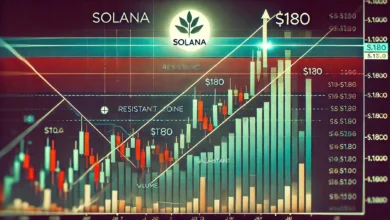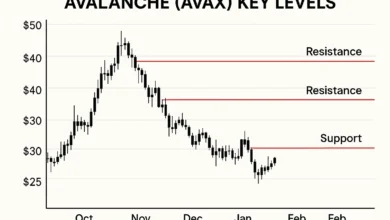Bitcoin Fragile Support and the Rapidly Shifting Altcoin Landscape
Bitcoin fragile support is testing traders as the altcoin landscape shifts. See what it means for BTC dominance, risk, and your crypto strategy.

When markets slow to a nervous crawl, the real story begins beneath the candles. Bitcoin’s fragile support zones, the places where dip buyers keep stepping in, are being tested more often—and each test chips away at confidence. At the same time, a shifting altcoin landscape is tempting traders with bursts of performance that can vanish as quickly as they appear. If you’re trying to navigate this moment, you’re not alone. The contradictory signals—BTC dominance edging up one week and altcoins rallying the following, funding rates flipping from positive to negative overnight, open interest swelling into squeezes—can feel like noise until you recognize the patterns tying them together.
Bitcoin’s Fragile Support
What makes a support level “fragile”?
A support level becomes fragile when buyers repeatedly defend the same price area but fail to push the price into a new, secure range. Each retest consumes limit buy orders resting in the order book. As these orders get filled, liquidity thins, making it easier for one sharp sell impulse to pierce the floor. You’ll often see wicky candles, narrowing ATR (average true range), and declining spot volume at support. Combined, these signals warn that buying power is present but timid.
In crypto, fragility is amplified by perpetual futures feedback loops. If funding rates oscillate near zero and open interest climbs without decisive spot demand, a small move can cascade into liquidations. This is why a support that looks solid on the daily chart can suddenly give way during low-liquidity hours.
Identifying the “real” line in the sand
Not all supports are equal. A level defended by high-volume spot buyers is sturdier than one upheld by overleveraged longs. Look for volume profile nodes where sustained trading is clustered, and confirm with on-chain metrics such as realized price bands or large UTXO age bands that imply long-term holders acquired near that area. If you see whale wallets and long-term holders increasing balances while derivatives metrics stay calm, the foundation is firmer. When long-term cohorts distribute into every rally and funding flips euphorically quickly, the floor is more cosmetic than structural.
From defense to offense: turning holds into higher highs
Fragile doesn’t have to mean doomed. Support can strengthen if the price consolidates above it while spot-led accumulation returns. The tell is a drift from lower-timeframe chop to higher-timeframe structure: higher lows forming on the 4H and daily, market structure flipping from distribution to accumulation, and BTC dominance stabilizing as capital stops panic-rotating. When the first breakout attempt fails but the second holds with rising spot volume and tame funding, you’re witnessing a defensive stand morph into an offensive push.
Why Altcoins Are Moving in Shifting, Uneven Waves

The rotation problem: when does money pivot away from BTC?
Historically, capital tends to move in phases: fiat → Bitcoin → large-cap altcoins → mid/small caps → narrative plays. In a fragile-support environment, that neat sequence fractures. Traders test altcoin rotation when they sense upside asymmetry, but they yank liquidity back to BTC at the first sign of instability. The result is a shifting altcoin landscape where sector-specific narratives (for example, DeFi upgrades, L2 scaling, modular blockchains, or AI-linked tokens) pop selectively while the broader market remains hesitant.
The key to reading these waves is tracking relative strength rather than absolute returns. When Bitcoin ranges but a basket of majors—think quality L1s and L2s—holds higher lows against BTC pairs, rotation has legs. If everything bleeds on BTC weakness and only memecoins flash short-lived spikes, the rotation is more reflex than regime change.
Liquidity fragmentation and the narrative flywheel
Altcoin rallies need two ingredients: narrative and sustained liquidity. An early catalyst—devnet milestones, tokenomics updates, or major integrations—pulls attention, but the rally stays alive only if spot volume and depth build across exchanges. When liquidity is shallow, wick-hunting becomes common and the flywheel stalls. Watch order book depth and spreads; tightening spreads and thicker depth signal more durable participation. In contrast, if a token pumps on thin liquidity and perp skew goes extreme, expect mean reversion once the catalyst fades.
BTC dominance as a weather vane, not a law
BTC dominance rising doesn’t automatically kill altcoin performance, and falling doesn’t guarantee an altseason. Treat dominance as a context indicator. If dominance increases while BTC ascends on heavy spot volume, altcoins can still outperform in USD terms even if they lag on BTC pairs. Conversely, when dominance drops because BTC is drifting while capital speculates in low-liquidity alts, the risk of sharp give-backs rises. The healthiest rotation appears when BTC consolidates above reclaimed support and dominance stabilizes or drifts modestly lower while quality altcoins hold breakouts.
Macro, ETFs, and the Psychology of Fragile Floors
Macro crosswinds and crypto’s reflexivity
Crypto is reflexive: price changes alter investor behavior, which feeds back into price. Macro headwinds—from interest-rate expectations to dollar strength—can wobble crypto even when crypto-native flows are steady. The way to incorporate macro without overfitting is simple: note whether risk assets broadly are absorbing bad news. If equities and credit spreads are calm while BTC struggles to hold basic levels, the issue is inside crypto (distribution, leverage, or narrative fatigue). If global risk wobbles, be slower to fade weakness.
ETF flows and the spot versus derivatives tug-of-war
Spot-led demand is the antidote to fragile support. Institutional flows via spot ETFs—when net positive—help convert fragile floors into durable bases because they represent unlevered, deliverable buying that reduces the proportion of hot money in the system. Derivatives-led bounces can kickstart a rally, but they rarely sustain it without spot confirmation. That’s why monitoring the balance between spot inflows and perp positioning matters more than any single headline.
The crowd at the edge of the cliff
Fragile support is also a psychological edge. Traders crowd into the same invalidation point because it’s “obvious.” This clustering creates stop-liquidity pools below the level. Smart money will sometimes push the prices through those pools to fill large bids at lower levels. Recognizing this dynamic keeps you from panic-selling on the first flush beneath support. The more times a level is “too obvious,” the less reliable it becomes as a hard stop. Place invalidations based on structure breaks (e.g., a daily close below key structure with volume) rather than a single wick.
Technical Frameworks to Read the Current Phase
Mapping the battlefield: higher timeframe first
Start with weekly and daily charts to mark HTF support and resistance. Identify where high-volume nodes and prior multi-week ranges overlap. Draw a few lines and respect them. Then drop to 4H and 1H to see whether the price is compressing into a coiled range or grinding along support. When the lower timeframes align with the higher timeframe thesis, your probability improves. If they contradict—HTF bearish, LTF bullish—size down and shorten your holding period.
Liquidity, wicks, and where reversals actually start
Crypto reversals rarely start in the middle of a range. They often begin after price taps a liquidity pocket—below a local low or above a recent high—then reverses with strong absorption. Look for long wicks into prior swing points accompanied by volume spikes and a quick reclaim of the level. Follow-through matters: if price reclaims and consolidates above the swing on declining volatility and steady spot buying, the reversal quality is higher.
Signals that support is strengthening
There are recurring tells that a fragile level is gaining backbone:
-
Declining correlation between BTC and high-beta alts during dips, indicating selective resilience.
-
Funding rates are hovering near flat or slightly negative while spot accumulation persists.
-
Open interest rising after a flush but with a bias toward defensive hedges rather than euphoric longs.
-
On-chain transfer volume rising to exchanges during rallies (profit-taking) but falling on dips (reduced panic).
-
Realized cap and long-term holder supply steadying around the defended area.
None of these is a silver bullet alone. Together, they shift the odds.
Navigating the Shifting Altcoin Landscape
Quality filters in a noisy field
When rotations are choppy, demand higher standards. Favor altcoins with clear token economics, tangible network demand, and roadmaps that are actually shipping. Protocols with growing active users, rising fee revenue, or meaningful developer traction generally hold up better in shaky BTC conditions. This doesn’t mean you ignore momentum; it means you make momentum compete with fundamentals.
Look for catalysts you can timestamp: mainnet launches, token unlock schedules that decline over time, fee-sharing changes, or concrete DeFi integrations. Avoid unthinkingly chasing memecoins unless you treat them as ultra-short-term momentum trades with tight invalidations and no attachment.
Timing entries with BTC context

Altcoin entries have two clocks: their own and Bitcoin’s. Your best setups typically appear when BTC is either trending cleanly upward or compressing tightly above reclaimed support. If BTC is skidding along fragile support with erratic wicks, altcoin breakouts are prone to failure. Condition your altcoin risk on BTC’s posture. Scale in when BTC is cooperative; scale out when it isn’t.
Pair selection: USD versus BTC pairs
Trading altcoins on USD pairs hides relative weakness during a Bitcoin advance. To see whether rotation is actually occurring, check BTC pairs. If an alt is printing higher highs against BTC while BTC itself is stable or rising, you’ve found genuine relative strength. If USD charts look fine but BTC pairs trend down, you’re likely riding a beta move that fizzles when BTC pauses.
Risk sizing and exits in a regime of fakeouts
Fragile-support regimes breed fakeouts. Preserve capital by keeping position sizes modest, using time-based stops if levels are sticky, and predefining partial exits into strength. Focus on asymmetric trades where the invalidation is close and the upside has room to run toward a previous weekly supply zone. If an alt fails a breakout and re-enters the prior range, assume the move is over until price reclaims with authority.
Risk Management: Turning Uncertainty into Structure
Build a playbook, not guesses
Codify your process. Before you click buy, write down the thesis, trigger, invalidation, and targets. If the thesis was “BTC holds weekly support and alts sustain higher lows on BTC pairs,” then your invalidation is straightforward: if BTC loses support on a daily close and alt BTC pairs roll over, you exit. This is how you translate market structure into disciplined decision-making.
Hedge light, hedge right
When support looks fragile, hedging can reduce stress—but keep it purposeful. Shorting a small basket of perps against a long spot portfolio can smooth volatility without forcing you to time all exits. Alternatively, options structures such as protective puts or call spreads can cap downside while preserving upside. The goal is not to be “clever”; it’s to survive the chop so you’re present for the next clean trend.
Keep cash optionality
In regimes where edges decay quickly, cash is a position. Rotating a slice of capital to stablecoins when signals deteriorate is not capitulation—it’s discipline. Optionality lets you buy the reclaim after a flush instead of watching from the sidelines, paralyzed. Emotional capital is as real as financial capital; protect both.
Case Study Frameworks You Can Apply Today
The reclaim after the sweep
Price trades into a known stop-liquidity pool below well-watched support, wicks deep, and reclaims the level within the same session. Volume surges on the reclaim while funding rates remain neutral or negative. That is your signal to plan a long with invalidation below the wick low and targets set at the range mid and prior high. This is one of the highest-quality patterns in fragile-support environments because it combines liquidity dynamics with proof of absorption.
The fake breakout that doesn’t get you twice
An altcoin breaks above a multi-week range on thin volume while BTC chops at support. Perp skew goes euphoric, but spot lags. When the breakout fails and the price returns to the range, step aside. If the alt later reclaims the range high with strong spot participation and BTC is now resting above its reclaimed support, you have a second-chance entry with better odds. Patience converts false starts into precise re-entries.
The steady grinder
Sometimes the best trades are boring. A large-cap alt quietly prints higher lows and higher highs on the daily, while BTC meanders. Funding is flat, spot accumulation shows in the tape, and developer updates drip steadily. These grinders often outperform because they don’t rely on manic rotations. They also allow more precise risk placement because the structure is clean.
Putting It All Together
Bitcoin’s fragile support sets the tone for the entire market. Fragile doesn’t mean failing, but it does demand respect. Combine higher-timeframe structure with real-time flow signals to judge whether floors are strengthening or eroding. In altcoins, recognize that the landscape is shifting rather than uniformly trending; quality, liquidity, and timing matter more than ever.
Treat BTC dominance as context, not gospel. Anchor decisions in spot versus derivatives balance, narrative quality, and the alignment of BTC posture with your alt entries. If you route every decision through the same checklist—Is spot leading? Are we above reclaimed support? Are BTC pairs confirming? Does real usage back the narrative?—You’ll reduce noise, avoid unnecessary churn, and be ready when a fragile floor becomes a launchpad.
Conclusion
The current phase rewards traders who can read fragility without panicking and who can embrace rotation without overchasing it. When Bitcoin’s fragile support holds through volatility and spot demand underpins the bid, altcoins find the stability they need to mount durable moves. When the floor cracks or proves only cosmetic, rotations fragment and fakeouts multiply. Your edge comes from respecting the structure, demanding quality in altcoin bets, and keeping risk management non-negotiable. Survive the chop, and you’ll be present for the next clean leg—whether it’s a renewed Bitcoin trend or a more orderly, shifting altcoin landscape that broadens participation.
FAQs
Q: What exactly signals that Bitcoin’s support has turned from fragile to strong?
Strength shows up when price consolidates above the defended level with rising spot volume, stable or slightly negative funding rates, and declining volatility. A sequence of higher lows on the 4H/daily and reduced correlation between BTC dips and altcoin collapses reinforce the transition from defense to stability.
Q: Can altcoins perform well even if BTC dominance rises?
Yes. If BTC’s dominance rises due to its trend with solid spot demand, many quality altcoins can still gain in USD terms. The risk increases when dominance rises due to a flight to safety during BTC weakness; in such cases, altcoins often underperform on both USD and BTC pairs.
Q: How do I avoid getting trapped in altcoin fakeouts?
Wait for confirmation beyond the first breakout. Look for spot-led follow-through, tightening spreads, and stability on BTC pairs. If a breakout re-enters its prior range, assume it failed and stand aside until the level is reclaimed with volume.
Q: Should I hedge in a fragile-support environment?
Light, targeted hedges can help. Small perp shorts against spot or simple options protection can reduce downside without forcing you to sell core positions at the worst moment. The goal is smooth equity curves, not hero trades.
Q: What role do on-chain metrics play in this analysis?
On-chain metrics validate or challenge what the chart suggests. Rising long-term holder supply near support, subdued exchange inflows on dips, and steady realized cap growth typically strengthen the case that a floor is real. Spikes in exchange inflows during every sell-off warn that weak hands are defending the level.









